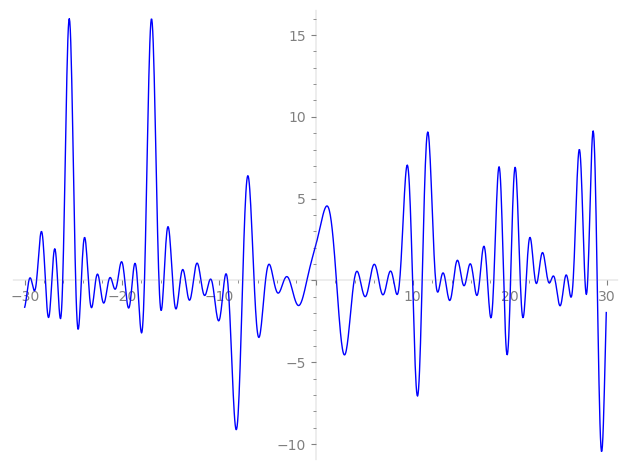| L(s) = 1 | + (1.22 − 2.11i)2-s + (0.333 + 0.578i)3-s + (−1.99 − 3.45i)4-s + (−0.455 + 0.788i)5-s + 1.63·6-s − 4.87·8-s + (1.27 − 2.21i)9-s + (1.11 + 1.92i)10-s + (−1.83 − 3.18i)11-s + (1.33 − 2.30i)12-s + 13-s − 0.607·15-s + (−1.97 + 3.42i)16-s + (−3.59 − 6.22i)17-s + (−3.12 − 5.41i)18-s + (0.989 − 1.71i)19-s + ⋯ |
| L(s) = 1 | + (0.865 − 1.49i)2-s + (0.192 + 0.333i)3-s + (−0.997 − 1.72i)4-s + (−0.203 + 0.352i)5-s + 0.667·6-s − 1.72·8-s + (0.425 − 0.737i)9-s + (0.352 + 0.610i)10-s + (−0.554 − 0.960i)11-s + (0.384 − 0.666i)12-s + 0.277·13-s − 0.156·15-s + (−0.493 + 0.855i)16-s + (−0.871 − 1.50i)17-s + (−0.736 − 1.27i)18-s + (0.226 − 0.392i)19-s + ⋯ |
Λ(s)=(=(637s/2ΓC(s)L(s)(−0.900+0.435i)Λ(2−s)
Λ(s)=(=(637s/2ΓC(s+1/2)L(s)(−0.900+0.435i)Λ(1−s)
| Degree: |
2 |
| Conductor: |
637
= 72⋅13
|
| Sign: |
−0.900+0.435i
|
| Analytic conductor: |
5.08647 |
| Root analytic conductor: |
2.25532 |
| Motivic weight: |
1 |
| Rational: |
no |
| Arithmetic: |
yes |
| Character: |
χ637(79,⋅)
|
| Primitive: |
yes
|
| Self-dual: |
no
|
| Analytic rank: |
0
|
| Selberg data: |
(2, 637, ( :1/2), −0.900+0.435i)
|
Particular Values
| L(1) |
≈ |
0.478176−2.08458i |
| L(21) |
≈ |
0.478176−2.08458i |
| L(23) |
|
not available |
| L(1) |
|
not available |
L(s)=p∏Fp(p−s)−1 | p | Fp(T) |
|---|
| bad | 7 | 1 |
| 13 | 1−T |
| good | 2 | 1+(−1.22+2.11i)T+(−1−1.73i)T2 |
| 3 | 1+(−0.333−0.578i)T+(−1.5+2.59i)T2 |
| 5 | 1+(0.455−0.788i)T+(−2.5−4.33i)T2 |
| 11 | 1+(1.83+3.18i)T+(−5.5+9.52i)T2 |
| 17 | 1+(3.59+6.22i)T+(−8.5+14.7i)T2 |
| 19 | 1+(−0.989+1.71i)T+(−9.5−16.4i)T2 |
| 23 | 1+(−0.298+0.516i)T+(−11.5−19.9i)T2 |
| 29 | 1+3.64T+29T2 |
| 31 | 1+(−3.54−6.13i)T+(−15.5+26.8i)T2 |
| 37 | 1+(0.355−0.615i)T+(−18.5−32.0i)T2 |
| 41 | 1−5.27T+41T2 |
| 43 | 1−11.0T+43T2 |
| 47 | 1+(6.05−10.4i)T+(−23.5−40.7i)T2 |
| 53 | 1+(−5.72−9.91i)T+(−26.5+45.8i)T2 |
| 59 | 1+(4.79+8.30i)T+(−29.5+51.0i)T2 |
| 61 | 1+(3.49−6.04i)T+(−30.5−52.8i)T2 |
| 67 | 1+(0.614+1.06i)T+(−33.5+58.0i)T2 |
| 71 | 1−11.3T+71T2 |
| 73 | 1+(3.26+5.65i)T+(−36.5+63.2i)T2 |
| 79 | 1+(−5.76+9.97i)T+(−39.5−68.4i)T2 |
| 83 | 1−7.16T+83T2 |
| 89 | 1+(6.42−11.1i)T+(−44.5−77.0i)T2 |
| 97 | 1−9.09T+97T2 |
| show more | |
| show less | |
L(s)=p∏ j=1∏2(1−αj,pp−s)−1
Imaginary part of the first few zeros on the critical line
−10.73063239336933365071981635093, −9.417606197898604867397568191891, −9.086838859231880776956249748600, −7.53111357967609151535754372159, −6.35411399190014041675806641152, −5.17547438041021622959405744268, −4.33329316621370691391763063256, −3.27526661618185708618707421708, −2.69861898932120978669218945956, −0.911221143111126059948230595038,
2.13477671766083700704479983465, 3.95796081167060601758589634014, 4.59098328407437423023924570829, 5.57364902169326114957576441868, 6.50359254536394360696330630464, 7.37885473308904339858733085077, 8.026084917981521573843772301304, 8.655197350739499023368567903055, 9.982016527578675106929996765347, 10.97190005761895829541595242678

